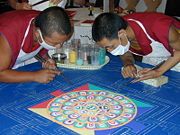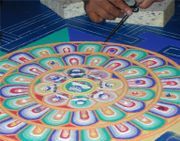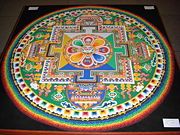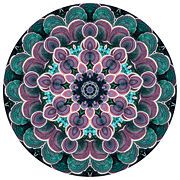Mandala
There are several meanings of mandala. The simplest is “circle.” Going deeper, it is the circle of the self.
Other meanings of mandala
In the West, mandala is also used to refer to the "personal world" in which one lives, the various elements of the mandala or the activities and interests in which one engages, the most important being at the centre of the mandala and the least important at the periphery. Depicting one's personal mandala in pictorial form can give one a good indication of the state of one's spiritual life.[citation needed]
In science fiction, geometric patterns akin to mandalas have been used to represent advanced technology with esoteric properties, such as the time travel mechanism in the 2007 movie The Last Mimzy[29] or the alien signal in the 2005 television show Threshold.
Also, in the newest Agent Pendergast novel The Wheel of Darkness, the titular agent is hired on to find an artifact of extreme danger and evil for a temple of monks. It is revealed that it is a painting of a mandala so intense that it destroys the mind of the viewer.
Wikipedia
Mandala Wiki
From Wikipedia, the free encyclopedia
Buddhist mandala
Mandala (Sanskrit maṇḍala "essence" +"having" or "containing". It is also translated as "circle-circumference" or "completion", both derived from the Tibetan term dkyil khor). Mandala is of Hindu origin, the term being used for the books of the Rig Veda.[citation needed] but is also used in other Indian religions such as Buddhism. In the Tibetan branch of Vajrayana Buddhism, mandalas have been developed into sandpainting. They are also a key part of anuttarayoga tantra meditation practices.
In various spiritual traditions, mandalas may be employed for focusing attention of aspirants and adepts; as a spiritual teaching tool; for establishing a sacred space; and as an aid to meditation and trance induction. According to David Fontana, its symbolic nature can help one "to access progressively deeper levels of the unconscious, ultimately assisting the meditator to experience a mystical sense of oneness with the ultimate unity from which the cosmos in all its manifold forms arises." [1] The psychoanalyst Carl Jung saw the mandala as "a representation of the unconscious self,"[2] and believed his paintings of mandalas enabled him to identify emotional disorders and work towards wholeness in personality.[3]
In common use, mandala has become a generic term for any plan, chart or geometric pattern that represents the cosmos metaphysically or symbolically, a microcosm of the Universe from the human perspective.[edit]
In Hinduism
A Hindu Mandala
A Hindu temple's decoration. Mandala is the term used to describe the books of the Rig Veda.
In Buddhism
![]()
Painted 17th century Tibetan 'Five Deity Mandala', in the center is Rakta Yamari (the Red Enemy of Death) embracing his consort Vajra Vetali, in the corners are the Red, Green White and Yellow Yamaris, Rubin Museum of Art
Painted 19th century Tibetan mandala of the Naropa tradition, Vajrayogini stands in the center of two crossed red triangles, Rubin Museum of Art
Bhutanese Medicine Mandala. Medicine Buddha painted mandala with goddess Prajnaparamita in center, 19th century, Rubin Museum.
Painted Bhutanese Medicine Buddha mandala with the goddess Prajnaparamita in center, 19th century, Rubin Museum of Art
[edit]
Early and Theravada Buddhism
The mandala can be found in the form of the Stupa[4] and in the Atanatiya Sutta[5] in the Digha Nikaya, part of the Pali Canon. This text is frequently chanted.
Tibetan Vajrayana
![]()
Tibetan monks making a temporary "Sand-Mandala" in the City-Hall of Kitzbühel in Austria in 2002
![]()
Details of Sand-Mandala
![]()
Chenrezig Sand Mandala created at the House of Commons of the United Kingdom on the occasion of the Dalai Lama's visit in May 2008
A kyil khor (Tibetan for mandala) in Vajrayana Buddhism usually depicts a landscape of the Buddha land or the enlightened vision of a Buddha (which are inevitably identified with and represent the nature of experience and the intricacies of both the enlightened and confused mind): "a microcosm representing various divine powers at work in the universe."[6] Such mandalas consist of an outer circular mandala and an inner square (or sometimes circular) mandala with an ornately decorated mandala palace[7] placed at the center. Any part of the inner mandala can be occupied by Buddhist glyphs and symbols [8] as well as images of its associated deities, which "symbolise different stages in the process of the realisation of the truth." [9] Mandalas are commonly used by tantric Buddhists as an aid to meditation. More specifically, a Buddhist mandala is envisaged as a "sacred space," a Pure Buddha Realm[10] and also as an abode of fully realised beings or deities. [9] While on the one hand, it is regarded as a place separated and protected from the ever-changing and impure outer world of Samsara,[11] and is thus seen as a Buddhafield[12] or a place of Nirvana and peace, the view of Vajrayana Buddhism sees the greatest protection from samsara being the power to see samsaric confusion as the "shadow" of purity (which then points towards it). By visualizing purelands, one learns to understand experience itself as pure, and the abode of enlightenment. The protection we need, in this view, is from our own minds, as much as from external sources of confusion. In many tantric mandalas, this aspect of separation and protection from the outer samsaric world is depicted by "the four outer circles: the purifying fire of wisdom, the vajra circle, the circle with the eight tombs, the lotus circle."[13] The ring of vajras forms a connected fence-like arrangement running around the perimeter of the outer mandala circle[14] The mandala is also "a support for the meditating person,"[13] something to be repeatedly contemplated, to the point of saturation, such that the image of the mandala becomes fully internalised in even the minutest detail and which can then be summoned and contemplated at will as a clear and vivid visualised image. With every mandala comes what Tucci calls "its associated liturgy...contained in texts known as tantras,"[15] instructing practitioners on how the mandala should be drawn, built and visualised and indicating the mantras to be recited during its ritual use.
The photograph at right is a good example of a Tibetan sand mandala.[16] This pattern is painstakingly created on the temple floor by several monks who use small tubes and rub another metal object against the tube's notched surface to create a tiny flow of grains.[17] The various aspects of the traditionally fixed design represent symbolically the objects of worship and contemplation of the Tibetan Buddhist cosmology.
To symbolize impermanence (a central teaching of Buddhism), after days or weeks of creating the intricate pattern, the sand is brushed together and is usually placed in a body of running water to spread the blessings of the mandala.
The visualization and concretization of the mandala concept is one of the most significant contributions of Buddhism to Transpersonal Psychology. Mandalas are seen as sacred places which, by their very presence in the world, remind a viewer of the immanence of sanctity in the Universe and its potential in his or her self. In the context of the Buddhist path the purpose of a mandala is to put an end to human suffering, to attain enlightenment and to attain a correct view of Reality. It is a means to discover divinity by the realization that it resides within one's own self.
A mandala can also represent the entire Universe, which is traditionally depicted with Mount Meru as the axis mundi in the center, surrounded by the continents.[18] A 'mandala offering'[19] in Tibetan Buddhism is a symbolic offering of the entire Universe. Every intricate detail of these mandalas is fixed in the tradition and has specific symbolic meanings, often on more than one level.
The mandala can be shown to represent in visual form the core essence of the Vajrayana teachings. In the mandala, the outer circle of fire usually symbolises wisdom. The ring of 8 charnel grounds[20] probably represent the Buddhist exhortation to always be mindful of death and impermanence with which samsara is suffused: "such locations were utilized in order to confront and to realize the transient nature of life."[21] Described elsewhere thus: "within a flaming rainbow nimbus and encircled by a black ring of dorjes, the major outer ring depicts the eight great charnel grounds, to emphasize the dangerous nature of human life."[22] Inside these rings lie the walls of the mandala palace itself, specifically a place populated by deities and Buddhas.
One well-known type of mandala in Japan is the mandala of the "Five Buddhas", archetypal Buddha forms embodying various aspects of enlightenment, the Buddhas are depicted depending on the school of Buddhism and even the specific purpose of the mandala. A common mandala of this type is that of the Five Wisdom Buddhas (a.k.a. Five Jinas), the Buddhas Vairocana, Aksobhya, Ratnasambhava, Amitabha and Amoghasiddhi. When paired with another mandala depicting the Five Wisdom Kings, this forms the Mandala of the Two Realms.
[edit]
Mandala offering
Whereas the above mandala represents the pure surroundings of a Buddha, this mandala represents the Universe. This type of mandala is used for the mandala-offerings, during which one symbolically offers the Universe to the Buddhas or one's teacher for example. Within Vajrayana practice, 100,000 of these mandala offerings (to create merit) can be part of the preliminary practices before a student can begin with actual tantric practices.[23] This mandala is generally structured according to the model of the Universe as taught in a Buddhist classic text the Abhidharma-kośa, with Mount Meru at the centre, surrounded by the continents, oceans and mountains, etc.
Shingon Buddhism
Japanese
Buddhism
The Japanese branch of Vajrayana Buddhism, Shingon Buddhism, makes frequent use of mandalas in their rituals as well, though the actual mandalas differ. When Shingon's founder, Kukai returned from his training in China, he brought back two mandalas that became central to Shingon ritual: the Mandala of the Womb Realm and the Mandala of the Diamond Realm.
These two mandalas are engaged in the abhiseka initiation rituals for new Shingon students, more commonly known as the Kechien Kongo (結縁潅頂). A common feature in this ritual is to blindfold the new initiate and have them throw a flower upon either mandala. Where the flower lands assists in the determination of which tutelary deity the initiate should follow.
Sand Mandalas, as found in Tibetan Buddhism, are not practiced in Shingon Buddhism.
[edit]
Nichiren Buddhism
The mandala in Nichiren Buddhism is called a moji-mandala (文字曼陀羅) and is a hanging paper scroll or wooden tablet whose inscription consists of Chinese characters and medieval-Sanskrit script representing elements of the Buddha's enlightenment, protective Buddhist deities and certain Buddhist concepts. Called the Gohonzon, it was originally inscribed by Nichiren, the founder of this branch of Japanese Buddhism, during the late 13th Century. The Gohonzon is the primary object of veneration in some Nichiren schools and the only one in others, which consider it to be the supreme object of worship as the embodiment of the supreme Dharma and Nichiren's inner enlightenment. The seven characters Nam Myoho Renge Kyo, considered to be the name of the supreme Dharma and the invocation that believers chant, are written down the center of all Nichiren-sect Gohonzons, whose appearance may otherwise vary depending on the particular school and other factors.
[edit]
Pure Land Buddhism
Mandalas have sometimes been used in Pure Land Buddhism to graphically represent the Pure Land, based on descriptions found in the Larger Sutra and the Contemplation Sutra. The most famous in Japan is the Taima Mandala dated approximately to 763, based on the Contemplation Sutra, but other similar mandalas have been made subsequently. Unlike mandalas used in Vajrayana Buddhism, it is not used as an object of meditation or for esoteric ritual. Instead, it provides a visual pictorial of the Pure Land texts, and is used as a teaching aid.
Also in Jodo Shinshu Buddhism, Shinran and his descendant, Rennyo, sought a way to create easily accessible objects of reverence to the lower-classes of Japanese society. Shinran designed a mandala using a hanging scroll, and the words of the nembutsu (南無阿彌陀佛) written vertically. This style of mandala is still used by some Jodo Shinshu Buddhists in home altars, or butsudan.
[edit]
In Judaism
In the Zohar is written, “There exists no circle in the world which is not made from within a single point which is located in the center…and this point, which is located in the center, receives all the light, illuminates the body, and all is enlightened.”[24] The Star of David symbol, adopted by Judaism in the middle ages, is a common motif found in mandalas.
[edit]
In Christianity
Cowen (2005: p.?),[who?] holds that mandala-esque forms are prevalent throughout Christianity: celtic cross; rosary; halo; aureole; oculi; Crown of Thorns; rose windows; Rosy Cross(although most of these were not actual christian "artifacts", they were only implemented after the dark ages of constantine)'; dromenon[25] on the floor of Chartres Cathedral. The dromenon represents a journey from the outer world to the inner sacred centre where the Divine is found.[26]
Similarly, many of the Illuminations of Hildegard von Bingen can be used as Mandalas, as are many of the images of esoteric Christianity (e.g., Christian Hermeticism, Christian Alchemy & Rosicrucianism).
[edit]
In Islam
In Islam, sacred art is dominated by geometric shapes with segments of the circles. According to Buddhist writer David Fontana, the entire building of the mosque becomes a mandala as the dome of the roof represents the arch of the heavens and turns the worshipper's attention towards Allah.[27]
[edit]
Medicine wheel as mandala
Medicine wheels are stone structures built by the natives of North America for various spiritual and ritual purposes. Medicine wheels were built by laying out stones in a circular pattern that often looked like a wagon wheel lying on its side. The wheels could be large, reaching diameters of 75 feet. Although archeologists are not definite on the purpose of each medicine wheel, it is considered that they had ceremonial and astronomical significance. Medicine wheels are still used today in the Native American spirituality, however most of the meaning behind them is not shared amongst non-Native peoples. Dream catchers are also mandalas.
[edit]
Bora ring as mandala
![]()
A contemporary mandala made from a photograph of tree fungi.
A Bora is the name given both to an initiation ceremony of Indigenous Australians, and to the site Bora Ring on which the initiation is performed. At such a site, young boys are transformed into men via rites of passage. The word Bora was originally from South-East Australia, but is now often used throughout Australia to describe an initiation site or ceremony. The term "bora" is held to be etymologically derived from that of the belt or girdle that encircles initiated men. The appearance of a Bora Ring varies from one culture to another, but it is often associated with stone arrangements, rock engravings, or other art works. Women are generally prohibited from entering a bora. In South East Australia, the Bora is often associated with the creator-spirit Baiame. Bora rings, found in South-East Australia, are circles of foot-hardened earth surrounded by raised embankments. They were generally constructed in pairs (although some sites have three), with a bigger circle about 22 metres in diameter and a smaller one of about 14 metres. The rings are joined by a sacred walkway. Matthews (1897)[28] gives an excellent eye-witness account of a Bora ceremony, and explains the use of the two circles.
[edit]
[edit]
See also
[edit]
References
- ^ See David Fontana: "Meditating with Mandalas", p. 10
- ^ Mandalas - Crystalinks
- ^ See C G Jung: Memories, Dreams, Reflections, pp.186-197
- ^ Prebish & Keown, Introducing Buddhism, ebook, Journal of Buddhist Ethics, 2005; printed edn, Routledge, 2006; page 89
- ^ Skilling, Mahasutras, volume II, parts I & II, Pali Text Society, pages 553ff
- ^ Mandala, The Mandala, Mandala Design, Largest Mandala, Buddha's Life Stages in Mandala, Mandala Paintings, Thanka Paintings, Work of Art, Asian art, Asian Paintings, Volunteer Work, Philanthropy, Donation for Preservation of Buddhist Religion
- ^ Mandala
- ^ http://www.jyh.dk/indengl.htm#Symbols Mandala by Jytte Hansen
- ^ a b Trans-Himalayan Murals
- ^ Lotsawa House | Chökyi Drakpa | Offering the Mandala
- ^ Sudden or Gradual Enlightenment
- ^ http://home.swipnet.se/ratnashri/ngondro.htm
- ^ a b Mandala
- ^ Mandala
- ^ The Mandala in Tibet
- ^ See Sand Mandala http://www.artnetwork.com/Mandala/
- ^ Mandala Construction Photos
- ^ Mipham (2000) pp. 65,80
- ^ The Meaning and Use of a Mandala
- ^ A Monograph on a Vajrayogini Thanka Painting
- ^ Charnel Grounds
- ^ http://www.sootze.com/tibet/mandala.htm
- ^ Preliminary Practice (Ngondro)
- ^ Tishbi, Vol.1:247
- ^ It is correctly termed a dromenon, not a maze nor labyrinth, as there is only one path to the centre.
- ^ See David Fontana: "Meditating with Mandalas", p. 11, 54, 118
- ^ See David Fontana: "Meditating with Mandalas", p. 11-12
- ^ The Burbung of the Darkinung Tribes, 1897, Matthews, R.H., 1897, Proceedings of the Royal Society of Victoria 10, 1: 1-12.
- ^ Spirituality web site review of the Last Mimzy
- Brauen, M. (1997). The Mandala, Sacred circle in Tibetan Buddhism Serindia Press, London.
- Bucknell, Roderick & Stuart-Fox, Martin (1986). The Twilight Language: Explorations in Buddhist Meditation and Symbolism. Curzon Press: London. ISBN 0-312-82540-4
- Cammann, S. (1950). Suggested Origin of the Tibetan Mandala Paintings The Art Quarterly, Vol. 8, Detroit.
- Cowen, Painton (2005). The Rose Window, London and New York, (offers the most complete overview of the evolution and meaning of the form, accompanied by hundreds of colour illustrations.)
- Fontana, David (2005). "Meditating with Mandalas", Duncan Baird Publishers, London.
- Gold, Peter (1994). Navajo & Tibetan sacred wisdom: the circle of the spirit. ISBN 0-89281-411-X. Rochester, Vermont: Inner Traditions International.
- Grossman, Sylvie and Barou, Jean-Pierre (1995). Tibetan Mandala, Art & Practice The Wheel of Time, Konecky and Konecky.
- Mipham, Sakyong Jamgön (2002) 2000 Seminary Transcripts Book 1 Vajradhatu Publications ISBN 1-55055-002-0
- Tucci,Giuseppe (1973). The Theory and Practice of the Mandala trans. Alan Houghton Brodrick, New York, Samuel Weisner.
- Vitali, Roberto (1990). Early Temples of Central Tibet London, Serindia Publications.
- Wayman, Alex (1973). "Symbolism of the Mandala Palace" in The Buddhist Tantras Delhi, Motilal Banarsidass.
[edit]
External links
- Introduction to Mandalas
- Rotation Point Mandala and Frequency Chord Projection by Michael Schreiber, The Wolfram Demonstrations Project.
This page was last modified on 27 October 2008, at 02:37. All text is available under the terms of the GNU Free Documentation License. (See Copyrights for details.)
Wikipedia® is a registered trademark of the Wikimedia Foundation, Inc., a U.S. registered 501(c)(3) tax-deductible nonprofit charity.